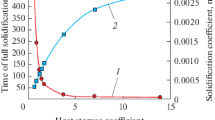The authors have proposed models of formation of structures of materials of ceramic molds for investment casting of heat-resistant alloys with aggregates of coarse and fi ne powders and binders formed in the process of heat treatment of hydrolyzed ethyl silicate ÉTS-40 and silica sol. Diffusion processes occurring during the interaction of the aggregates with the binder and the crystallization of the binder have been investigated. The thermal conductivity of the indicated materials has been calculated and the influence of the preliminary heat treatment of the material on it has been determined. A comparison of calculation results and experimental data has been made.
Similar content being viewed by others
References
E. N. Kablov (Ed.), Cast Blades of Gas-Turbine Engines: Alloys, Technologies, and Coatings [in Russian], 2nd edn., Nauka, Moscow (2006).
A. S. Lakeev, Mold Making in Precision Casting [in Russian], Naukova Dumka, Kiev (1986).
Ya. I. Shklennik and V. A. Ozerov (Eds.), Investment Casting [in Russian], 3rd edn., Mashinostroenie, Moscow (1984).
E. N. Kablov, Yu. A. Bondarenko, and D. E. Kablov, Features of the structure and heat-resistant properties of <100> single crystals of a high-rhenium nickel heat-resistant alloy obtained under the conditions of high-gradient directional crystallization, Aviats. Mater. Tekhnol., No. 4, 25–31 (2011).
E. N. Kablov, Innovative developments of the FGUP "VIAM" GNTs (Federal State Unitary Enterprise "All-Russia Institute of Aviations Materials" State Science Center) of the Russian Federation on implementation of the "Strategic Lines of Development of Materials and Technologies of Their Processing for the Period to the Year 2030," Aviats. Mater. Tekhnol., No. 1 (34), 3–33 (2015); DOI: 10.18577/2071-9140-2015-0-1-3-33.
E. N. Kablov, N. V. Petrushin, I. L. Svetlov, and I. M. Demonis, Nickel casting heat-resistant alloys of new generation, Aviats. Mater. Tekhnol., No. S, 36–52 (2012).
É. G. Arginbaeva and O. A. Bazyleva, Investigation into the structure and physicomechanical properties of intermetallide nickel alloys, Aviats. Mater. Tekhnol., No. 4, 14–19 (2013).
Yu. I. Folomeikin, E. N. Kablov, and I. M. Demonis, Superduty refractory ceramic rods and molds for casting of blades by the directional-crystallization method, Aviats. Mater. Tekhnol., No. 1, 33–34 (2003).
E. N. Kablov, V. V. Deev, Yu. A. Bondarenko, and A. R. Narskii, Silica-free ceramic molds for directional crystallization in casting gas-turbine-engine blades, Lit. Proizvodstvo, No. 5, 17–20 (2003).
G. N. Dul′ev and Yu. P. Zarichnyak, Thermal Conductivity of Mixtures and Composite Materials [in Russian], Énergiya, Leningrad (1974).
G. N. Dul′ev and V. V. Novikov, Transfer Processes in Inhomogeneous Media [in Russian], Énergoatomizdat, Leningrad (1991).
I. S. Matusevich, On sintering of ceramic molds and rods, Lit. Proizvodstvo, No. 9, 20–31 (1976).
Ya. E. Geguzin, The Physics of Sintering [in Russian], 2nd edn., Nauka, Moscow (1984).
E. A. Litovskii and N. A. Puchkelevich, Thermophysical Properties of Refractories: A Handbook [in Russian], Stroiizdat, Moscow (1984).
D. P. Volkov and Yu. P. Zarichnyak, Simulation of the structure and calculation of the thermal conductivity of polydispersed granular systems, J. Eng. Phys. Thermophys., 41, No. 1, 1065–1069 (1981).
L. V. Radushkevich and V. A. Kolchanov, Capillary-confined liquid in disperse systems of contacting particles, Kolloidn. Zh., 23, No. 1, 86–94 (1961).
Ya. E. Geguzin, Diffusion Zone [in Russian], Nauka, Moscow (1979).
I. G. Chumak and V. G. Pogontsev, Heat-transfer mechanism at a gas-fiber boundary, J. Eng. Phys. Thermophys., 36, No. 1, 37–42 (1979).
R. E. Krzhizhanovskii and Z. Yu. Shtern, Thermophysical Properties of Nonmetallic Materials. Oxides: A Reference Book [in Russian], Énergiya, Leningrad (1973).
Yu. V. Loshchinin, Yu. I. Folomeikin, T. P. Rykova, P. S. Marakhovskii, and S. I. Pakhomkin, Thermophysical properties of ceramic materials of molds and rods for casting of gas-turbine-engine blades from heat-resistant alloys, Materialovedenie, No. 3, 47–52 (2014).
A. V. Zuev, M. G. Razmakhov, D. Ya. Barinov, and P. S. Marakhovskii, Calculational and experimental investigation into the thermal conductivity of materials of ceramic casting molds. I. Experiment, J. Eng. Phys. Thermophys., 92, No. 3, 832–837 (2019).
Author information
Authors and Affiliations
Corresponding author
Additional information
Translated from Inzhenerno-Fizicheskii Zhurnal, Vol. 92, No. 3, pp. 838–845, May–June, 2019.
Rights and permissions
About this article
Cite this article
Zuev, A.V., Folomeikin, Y.I. & Barinov, D.Y. Calculational and Experimental Investigation into the Thermal Conductivity of Materials of Ceramic Casting Molds. II. Calculation. J Eng Phys Thermophy 92, 812–819 (2019). https://doi.org/10.1007/s10891-019-01990-y
Received:
Published:
Issue Date:
DOI: https://doi.org/10.1007/s10891-019-01990-y




